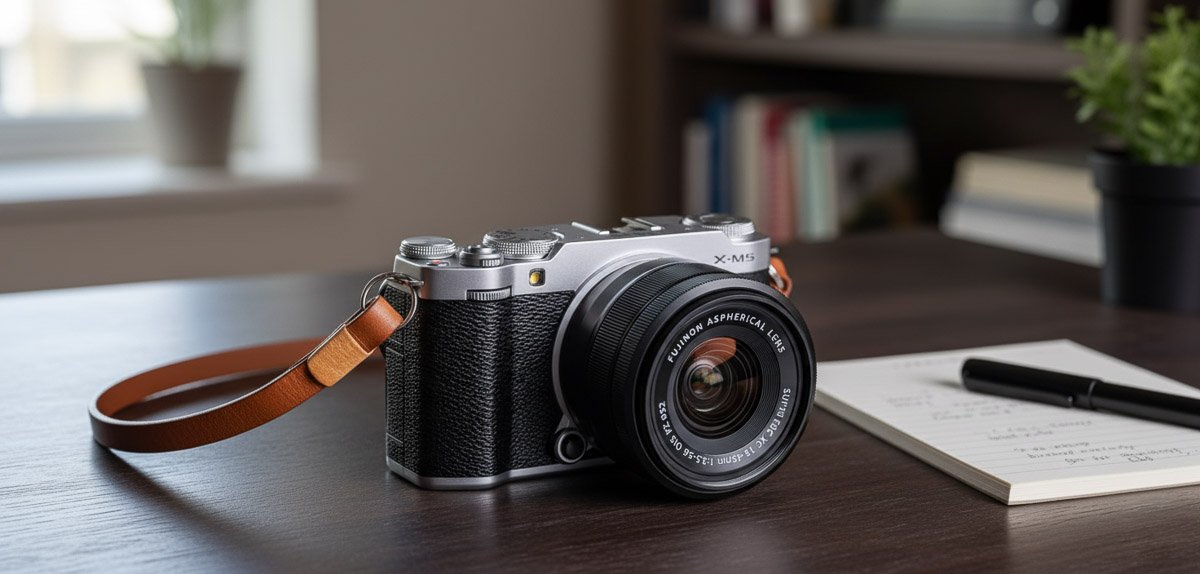5 Surprising Truths About the Fujifilm X-M5 That No One is Talking About
Introduction: The Perfect Small Camera Doesn't Exist... Or Does It?
The search for the ultimate compact camera is a familiar quest for content creators. We want a device that’s small enough to carry everywhere but powerful enough to deliver professional results without compromise. Into this crowded market, Fujifilm has launched not just another camera, but a calculated market play. The Fujifilm X-M5 is a disruptive statement aimed squarely at a growing creator segment that competitors like Sony have traditionally dominated. On the surface, it’s a simple, entry-level body, but a closer look reveals a camera built on a series of deliberate, surprising, and strategic compromises. This article explores five key truths that peel back the layers of this pocket-sized powerhouse to reveal its true identity.
1. It’s Not a Camera for Everyone - It’s a Specialized Creator Tool
The first thing to understand about the X-M5 is that it isn't a general-purpose "hybrid" camera. Instead, it's a masterclass in intentional compromise, specifically designed for vloggers, social media creators, and travel photographers. With this model, Fujifilm has adopted a "creator-first, photographer-second" philosophy, strategically ceding the traditionalist market to focus resources on the creator niche.
The camera's feature set acts as a functional filter. It actively attracts its target demographic—those accustomed to a screen-centric workflow—by prioritizing a fully articulating screen, advanced video modes, and superior audio capture. In fact, the X-M5 is the first X-Series model to feature a three-microphone array with four directional priority modes (Surround, Front, Back, and Front & Back), a key hardware upgrade for vloggers. Simultaneously, it discourages traditional photographers who would see its omissions, like the lack of a viewfinder, as critical flaws. The X-M5 isn't trying to please everyone; it's engineered to be the perfect tool for a very specific user.
2. Its Biggest Compromises Are Its Defining Features
The most-discussed "flaws" of the X-M5 are not oversights. The lack of a viewfinder, no In-Body Image Stabilization (IBIS), and a tiny grip are deliberate design choices made to achieve its class-leading size, weight, and aggressive price point.
No Viewfinder (EVF) All composition is done via the 3.0-inch free-angle touchscreen. Official sources list a sharp 1.84 million-dot resolution, though some hands-on reviews have noted a lower 1.04 million-dot panel. For its target vlogging audience, this screen-only approach is a non-issue. For photographers in bright sunlight, however, it's a major drawback.
No In-Body Image Stabilization (IBIS) The camera relies on Digital Image Stabilization (DIS) for video, which reviewers found to be "warpy and wobbly" and comes with a significant crop factor of up to 1.32x to 1.44x. For smooth, professional-looking handheld footage, pairing the camera with optically stabilized (OIS) lenses is not just recommended—it's crucial.
Minimalist Ergonomics The grip is described as "nearly nonexistent," forcing a "pinch" style of holding that can lead to hand cramping. This design choice makes accessories like the TG-BT1 tripod grip or a small cage almost an essential part of the core user experience for any serious vlogging, transforming a flaw into a strategic assumption about user behavior.
3. It Has a Flagship Brain in an Entry-Level Body
The X-M5 is a masterstroke of supply-chain optimization and R&D allocation. Fujifilm has combined a proven, last-generation sensor with its latest, cutting-edge processor to deliver flagship performance where it matters most to creators.
The camera uses the well-regarded 26.1MP X-Trans CMOS 4 sensor from the acclaimed X-T4, but pairs it with the latest X-Processor 5 from the flagship X-T5. This "asymmetric upgrade" is a brilliant strategy: it delivers exceptional, AI-powered autofocus and high-spec video while saving costs on the already-excellent sensor, prioritizing processing power over pixel count—a direct reflection of creator priorities.
This is where the user must choose between technical perfection and creative experience. While the AI-driven subject detection is a huge leap forward, Fujifilm's autofocus is still its "Achilles heel," lagging behind the "clinical-grade" reliability of competitors like Sony. For general use and family photos, the AF is more than fine, but the performance gap becomes significant in demanding situations like sports and wildlife. For creators who can’t afford to miss a critical moment, this trade-off is the camera's central question.
You can "fix" colours - you can't fix missed focus.
4. 6.2K Open Gate is Its Social Media Superpower
The headline video feature of the X-M5 is more than just a high-resolution number; it's a powerful workflow tool built for the social media age. The camera can record in 6.2K "open gate," which means it uses the full 3:2 surface of its sensor.
The practical benefit of this is a "shoot once, deliver anywhere" workflow. A creator can film a single clip and then crop it for multiple platforms in post-production. This means you can frame your main subject in the center of a single horizontal shot, knowing you have ample vertical resolution to create a compelling 9:16 TikTok clip later without resorting to awkward reframing or significant quality loss. This capability gives the X-M5 a huge advantage over direct competitors that top out at 4K.
5. The New Film Simulation Dial is Surprisingly Divisive
One of the most prominent new features is the dedicated Film Simulation dial, but opinions on its utility are sharply divided.
The intended benefit is clear: it offers quick, tactile access to Fujifilm's famous color profiles. This is fantastic for JPEG shooters, encouraging creative, in-camera looks without digging through menus.
However, many RAW shooters and power users see it as a waste of valuable physical space. The dial can't be reassigned, it doesn't feature all 20 of Fujifilm's film simulations, and critically, it fails to save unique settings for each simulation. This inability to manage custom recipes is what transforms it from a useful tool into a "frustrating gimmick" for power users, who see it as a poor use of prime real estate.
Conclusion: A Bold Choice in a Crowded Market
The Fujifilm X-M5 is not a jack-of-all-trades. It is a highly specialized tool that makes a bold statement through its focused design and intentional compromises. Its primary appeal is undeniable: it packs class-leading video resolution and fantastic image quality into an ultra-compact body at an aggressive price.
Ultimately, the X-M5 forces a choice between the technical perfection offered by its rivals and the unique creative experience that defines Fujifilm. Is its hyper-focused, compromise-driven design the future for entry-level cameras, or does the perfect, do-it-all compact camera remain a dream?









January 02, 2014 at 07:39 am /
Lorem ipsum dolor sit amet, consectetuer adipiscing elit. Phasellus hendrerit. Pellentesque aliquet nibh nec urna. In nisi neque, aliquet vel, dapibus id, mattis vel, nisi. Sed pretium, ligula sollicitudin laoreet viverra, tortor libero sodales leo, eget blandit nunc tortor eu nibh. Nullam mollis. Ut justo.
January 18, 2014 at 13:29 am /
Hi There,
Donec nec justo eget felis facilisis fermentum. Aliquam porttitor mauris sit amet orci. Aenean dignissim pellentesque felis.
January 22, 2014 at 03:19 am /
Lorem ipsum dolor sit amet, consectetuer adipiscing elit. Phasellus hendrerit. Pellentesque aliquet nibh nec urna. In nisi neque, aliquet vel, dapibus id, mattis vel, nisi. Sed pretium, ligula sollicitudin laoreet viverra, tortor libero sodales leo, eget blandit nunc tortor eu nibh. Nullam mollis. Ut justo.